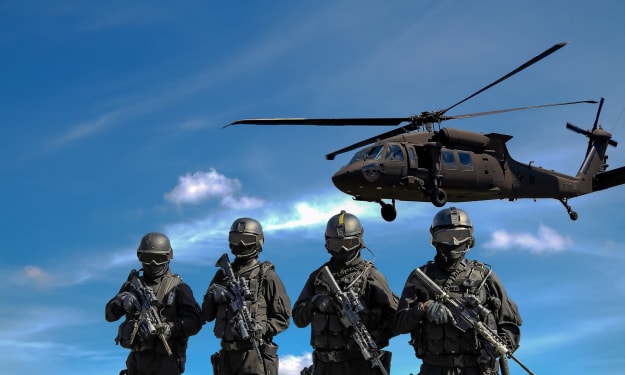Exploring the Top 10 Most Dangerous Borders in the World
The Dangerous military borders

Military borders are typically areas of high tension and potential conflict. They are often located in regions where there are unresolved territorial disputes, political instability, and ethnic or religious tensions. Military borders are typically heavily guarded and fortified, with military personnel and equipment stationed along the border to protect their country's interests.
I) Top 10 Most Dangerous Borders
• Border 1: Korean Demilitarized Zone (DMZ)-
The Korean DMZ is a 160-mile-long strip of land that separates North and South Korea. It is heavily fortified, with landmines, barbed wire, and watchtowers along its length. The area is known for its tension and occasional incidents of violence, making it one of the most dangerous military borders in the world.
• Border 2 : India-Pakistan
The border between India and Pakistan is one of the most heavily militarized borders in the world. The two countries have a long history of territorial disputes, religious tensions, and occasional outbreaks of violence. The border is heavily guarded and prone to incidents of cross-border firing and infiltration.
• Border 3 : Israeli-Palestinian Border
The Israeli-Palestinian border is a heavily guarded and volatile area, with ongoing conflicts between Israeli security forces and Palestinian militants. The area is marked by frequent violence, with occasional rocket attacks, suicide bombings, and clashes between Israeli security forces and Palestinian protesters.
• Border 4: Afghanistan-Pakistan
The border between Afghanistan and Pakistan is a mountainous and rugged terrain, making it difficult to monitor and secure. The area is known for its insurgency and drug trafficking, with frequent clashes between Pakistani security forces and Taliban militants.
• Border 5: Turkish-Syrian
The Turkish-Syrian border is a volatile area, with ongoing conflicts between Turkish security forces and Kurdish militants in Syria. The area is marked by frequent violence, including rocket attacks, airstrikes, and clashes between Turkish security forces and Kurdish rebels.
• Border 6: Chinese-Indian
The border between China and India is a disputed area, with frequent tensions over territorial claims and border incursions. The area is heavily militarized, with frequent clashes between Chinese and Indian security forces.
• Border 7: North Korea-China
The border between North Korea and China is a heavily guarded and tightly controlled area. The Chinese government has been known to crack down on North Korean refugees and asylum seekers, leading to tensions between the two countries.
• Border 8: Azerbaijan-Armenia
The border between Azerbaijan and Armenia is a disputed area, with ongoing conflicts over the Nagorno-Karabakh region. The area is heavily militarized, with frequent clashes between Azerbaijani and Armenian security forces.
• Border 9: Ukraine-Russia
The border between Ukraine and Russia is a volatile area, with ongoing conflicts over the annexation of Crimea and the conflict in eastern Ukraine. The area is heavily militarized, with frequent clashes between Ukrainian and Russian-backed separatist forces.
• Border 10: Thailand-Cambodia
The border between Thailand and Cambodia is a disputed area, with ongoing conflicts over the Preah Vihear temple. The area is marked by frequent clashes between Thai and Cambodian security forces, making it one of the most dangerous military borders in Southeast Asia.
II) Reasons for Danger-
Political tensions
Armed conflicts
Illegal crossings
Human trafficking
Smuggling of drugs and weapons
III) Impact on People's Lives-
-Refugee crisis
-Border communities
-Economic impact
IV) Border Security Measures
Physical barriers: It's are structures built along borders or boundaries to restrict or prevent movement across them. They can be constructed from a variety of materials, including concrete, steel, wire mesh, and barbed wire. Physical barriers can be used for various purposes, such as preventing illegal immigration, stopping drug trafficking, or deterring terrorist attacks.
Technological solutions: It's for border security involve the use of advanced technologies and digital tools to enhance border control, monitor illegal activities, and improve communication and coordination among law enforcement agencies. These solutions can include biometric scanners, facial recognition software, drones, sensors, cameras, and other surveillance systems that help detect and track suspicious activities.
Border patrol and law enforcement: Border patrol and law enforcement refer to the efforts made by countries to secure their borders and prevent unauthorized entry of individuals, goods, and illegal activities such as smuggling of drugs, weapons, and human trafficking.
Diplomacy and negotiations: Diplomacy and negotiations are key components of conflict resolution and international relations. Diplomacy involves the art of conducting negotiations between nations or groups to achieve a specific goal, often involving compromise and consensus-building.
In conclusion, military borders are typically areas of high tension and potential conflict, with ongoing territorial disputes, political instability, and ethnic or religious tensions. The danger level of a military border can vary depending on the specific circumstances and conflicts involved.






Comments
There are no comments for this story
Be the first to respond and start the conversation.